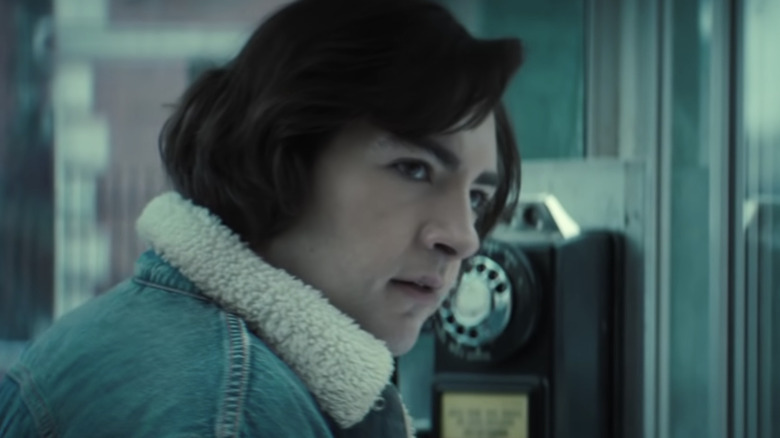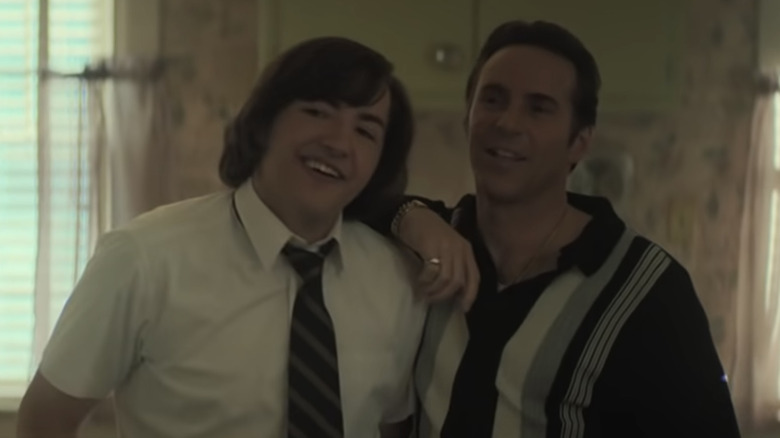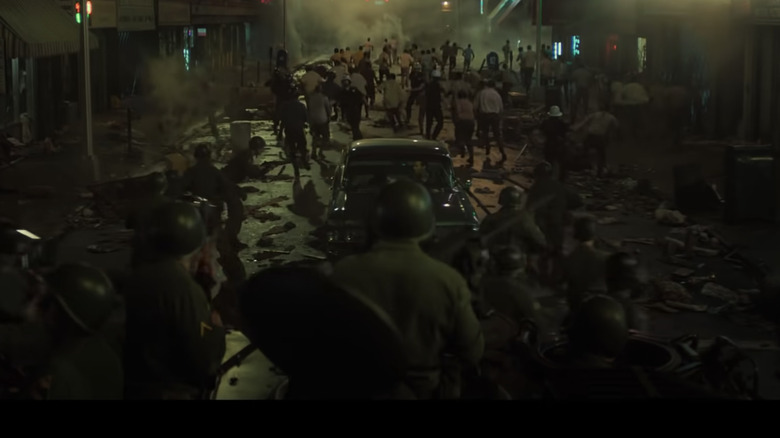The Many Saints Of Newark Ending Explained
Contains spoilers for "The Many Saints of Newark"
Set against the tumultuous backdrop of the 1967 Newark Riots, "The Many Saints of Newark" is a prequel to the beloved 1999 crime show "The Sopranos." The film is directed by Alan Taylor and written by David Chase and Lawrence Konner. Chase created the original "Sopranos" series and its colorful cast of characters. Starring Michael Gandolfini (James Gandolfini's son) as young Tony Soprano, "The Many Saints of Newark" chronicles the formative years of Tony as a kid and a teenager, and the impactful relationship he shared with his mob boss uncle Dickie Moltisanti (Alessandro Nivola). As fans well know, it would not exactly be a spoiler to say that young Tony grows up to follow in Uncle Dickie's footsteps.
"The Many Saints of Newark" boasts an impressive cast beyond the young Gandolfini. Many of these actors play younger versions of characters we grew to know, fear, and love on "The Sopranos" including Jon Bernthal (Giovanni "Johnny Boy" Soprano), Vera Farmiga (Livia Soprano), Corey Stoll (Corrado "Junior" Soprano), John Magaro (Silvio Dante), and Billy Magnusson (Paulie "Walnuts" Gualtieri), as reported by The New York Times. Veteran mob movie star Ray Liotta plays Aldo "Hollywood Dick" Moltisanti, whose character is rarely mentioned on the series, but whose actions nonetheless play an outsized role in the plot.
So how does this improbable prequel all end up? Does the ending serve as a logical prologue to "The Sopranos"? Or is it telling its own story, simply set in David Chase's universe? Why revisit these characters so long after the series took its final bow? Here's the ending of "The Many Saints of Newark" explained.
It's not really a Tony Soprano origin story
The opening shot gently pans over a gloomy graveyard, getting closer and closer to what is revealed to be Christopher's grave — yes, that Christopher. In the first few shots of the movie, the audience hears the voice over of Christopher Moltisanti (Michael Imperioli), who is a main character on "The Sopranos." It can be gleaned that Christopher is telling the story from beyond the grave. Since Christopher is a baby in the time period that "Many Saints" takes place, he hardly factors in the prequel story. Tony exclaims that the baby (who is his nephew) only ever cries when he is around, pretty deftly foreshadowing their tumultuous future relationship, which takes a murderous turn during the timeline of "The Sopranos." These little referential treats aside, the story of "Many Saints" doesn't really turn out to be about Tony or Christopher by the end. It's got a lot more to do with the man whose shadow extends over their relationship for decades to come.
While the movie is mostly framed through young Tony's point of view as he experiences the chaos and violence surrounding him and his family, the story is really more focused on the trials and tribulations of Dickie's life. In an interview with The Hollywood Reporter, director Alan Taylor asserts (about Tony) that, "It was important to feel him powerfully in the movie even though structurally it's Dickie's story." This certainly seems to suggest that the focus on Dickie is just as the creators intended.
This is part of the reason Christopher narrates instead of our present-day POV character, young Tony. Tony's environment and his pivotal bond with Dickie essentially morphs him into the New Jersey mob boss that he infamously becomes, but "Many Saints" proves to be more "The Legend of the Tennessee Moltisanti" than the Tony Soprano origin story.
Many Saints does provide new context for Tony, however
At the crux of the film are the tensions between the white and Black residents of Newark, New Jersey after a Black man is killed by the Newark police, a real life incident that resulted in uprisings that nearly burned the city down (per Film School Rejects). The generational conflict between the mob and the Black community is a constant presence in "Many Saints," with the heightened racial tensions serving as more setting than plot point. This ambient tension is made manifest in the story via the looming conflict between Dickie and a Black man named Harold McBrayer (Leslie Odom Jr.) with whom he used to do business.
When McBrayer turns against Dickie for killing one of his own, an all out war ensues between the two rival factions in Newark. It becomes a blood bath between the Italian mob and McBrayer and his crew, who are shown in one scene attending a meeting of The Black Panther Party. If racial and cultural tensions were always simmering beneath the surface on "The Sopranos," they claim top billing in the plot of "Many Saints." Even though the film is period piece of sorts, this choice makes it feel current and culturally relevant, and may even provide a fresh lens through which to revisit "The Sopranos."
Interestingly, the film's culminating act of violence isn't an act of racial animus, but rather a flagrant manifestation of the internecine conflicts within the Italian mob. This dynamic, too, will be familiar to fans of "The Sopranos" — no matter how many threats attack from without, it's always the threats from within that prove the most deadly. Toward the end of the film, Dickie is suddenly shot and killed by somebody who is revealed to have been hired by Junior Soprano, a member of the family who has always been at odds with Dickie. (It's once again interesting to consider the ways this struggle between Junior and Dickie replays a generation later between Junior and Tony.)
At Dickie's funeral, Tony stands staring at Dickie in the open casket. He imagines himself making a pinky swear with Dickie. It's a callback to a moment earlier in the film, but more importantly, it foreshadows the way Tony will continue Dickie's legacy.


